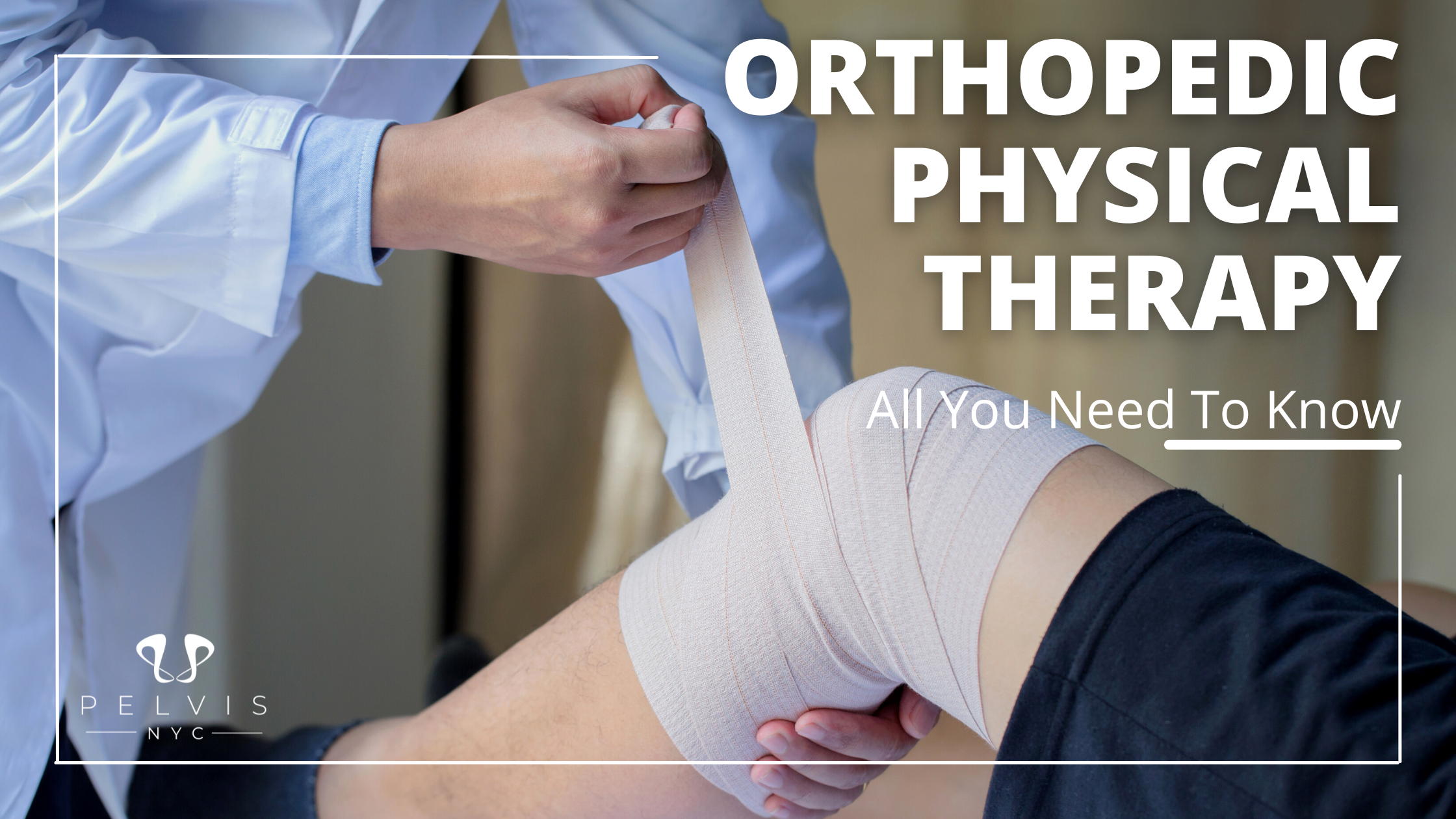Introduction: Let’s Talk About Orthopedic Therapy
At Pelvis NYC, we know how deeply joint pain and muscle tension can affect your day-to-day life. That’s why we offer comprehensive orthopedic physical therapy for men and women of all ages, treating everything from sports injuries and chronic back pain to post-surgical rehab and long-standing musculoskeletal issues.
But we don’t just treat isolated symptoms — our approach focuses on helping you move better, feel stronger, and return to the activities you love. Through personalized care and functional movement strategies, our mission is to guide you toward long-term relief, improved performance, and a more resilient, pain-free body.
What Is Orthopedic Physical Therapy?
Orthopedic physical therapy focuses on the musculoskeletal system—the intricate network of bones, muscles, joints, tendons, and ligaments that keep you moving. Our goal is to:
- Restore strength and flexibility
- Reduce pain and inflammation
- Improve mobility and function
- Prevent future injuries
One of the primary aims of orthopedic therapy is to relieve pain and improve quality of life.
Whether you’re dealing with a sports injury, recovering from surgery, or managing chronic conditions like arthritis, orthopedic therapy offers personalized strategies to get you back on track.
What Does an Orthopedic Physical Therapist Do?
As an orthopedic physical therapist, my role involves:
- Conducting comprehensive assessments to diagnose and identify movement dysfunctions
- Developing personalized treatment plans tailored to your specific needs
- Implementing hands-on techniques like manual therapy and dry needling
- Guiding you through therapeutic exercises to rebuild strength and mobility
- Collaborating with orthopedic doctors to ensure cohesive care
Our partnership is all about empowering you to take control of your recovery.
Reasons to See an Orthopedic Physical Therapist
You might consider seeing an orthopedic PT if you’re experiencing:
- Chronic joint or muscle pain
- Post-operative recovery needs (e.g., joint replacements, rotator cuff repairs)
- Acute injuries like sprains, strains, or dislocations
- Overuse injuries from repetitive motions
- Mobility issues due to aging or inactivity
- Low back pain impacting daily activities
Early intervention can prevent minor issues from becoming major setbacks.
Understanding the Musculoskeletal System
Your musculoskeletal system is the foundation of every movement you make. Here’s a quick breakdown:
| Component | Function |
| Bones | Provide structure, protect internal organs, and are crucial for overall bone health in orthopedic treatments |
| Muscles | Facilitate movement through contraction |
| Tendons | Connect muscles to bones |
| Ligaments | Connect bones and stabilize joints |
| Joints | Allow mobility and flexibility |
| Cartilage | Cushions joints to reduce friction |
| Connective Tissue | Supports and connects other tissues and organs |
When any part of this system is compromised—due to injury, overuse, or aging—orthopedic therapy can help restore balance and function.
Conditions Treated by Orthopedic Therapy
Orthopedic physical therapy is a versatile and effective approach to treating a wide range of musculoskeletal conditions. Whether you’re dealing with joint pain, knee pain, carpal tunnel syndrome, or an ankle fracture, orthopedic physical therapists are equipped to help you find relief and regain function.
Conditions We Treat at Pelvis NYC
We believe effective recovery begins with an accurate understanding of your condition. Our orthopedic physical therapy team combines clinical expertise with personalized care to treat a diverse range of joint and musculoskeletal disorders. Whether you’re navigating a recent injury or managing a long-standing issue, we’re here to help you restore movement, reduce pain, and return to doing what you love.
Common Orthopedic Conditions We Specialize In:
- Osteoarthritis
Degenerative joint changes that lead to pain, stiffness, and decreased mobility. - Sports-Related Injuries
From sprains and strains to overuse injuries, we help athletes of all levels recover safely. - Shoulder Dysfunction
Including rotator cuff tears, frozen shoulder, impingement syndrome, and instability. - Foot & Ankle Disorders
Conditions such as plantar fasciitis, Achilles tendonitis, and ankle sprains. - Spinal Pain (Neck & Low Back)
Treatment for disc issues, postural strain, and chronic spinal pain. - Chronic Pain Syndromes
Long-term pain conditions managed through manual therapy, movement re-education, and pain science education. - Elbow & Wrist Conditions
Issues like tennis elbow, golfer’s elbow, carpal tunnel syndrome, and repetitive strain injuries. - Hip & Knee Dysfunction
Common conditions include labral tears, patellofemoral syndrome, IT band syndrome, and arthritis-related stiffness. - Post-Operative Rehabilitation
Recovery support after surgeries such as total joint replacements, ACL repair, and spinal surgery. - Inflammatory Joint Conditions (e.g., Rheumatoid Arthritis)
Managing pain, preserving joint mobility, and maintaining function with tailored programs.
Orthopedic Doctors: Your Partners in Musculoskeletal Health
Orthopedic doctors specialize in diagnosing and treating conditions related to the musculoskeletal system. They can:
- Perform diagnostic imaging (X-rays, MRIs)
- Prescribe medications for pain or inflammation
- Administer injections (e.g., corticosteroids)
- Recommend physical therapy
- Perform surgeries when necessary, an orthopedic surgeon can address fractures, arthritis, and sports injuries
Collaborating with orthopedic doctors ensures a comprehensive approach to your care.
What to Expect at Orthopedic Physical Therapy
Your first visit typically includes:
- Initial Evaluation: Reviewing your medical history, assessing your symptoms, and conducting physical assessments
- Treatment Plan: Setting personalized goals for pain relief and improved function
- Manual Therapy: Hands-on techniques to reduce stiffness and enhance mobility
- Guided Exercises: Strength, coordination, and flexibility drills
- Education: Guidance on ergonomics, home exercises, and lifestyle adjustments
Consistency is key—most patients attend sessions 1–3 times per week for 4–12 weeks, depending on their condition.
Orthopedic Therapy for Different Types of Recovery
🛠️ Post-Surgical Rehabilitation
Essential after procedures like:
- Joint replacements (hip, knee, shoulder)
- Spinal surgeries
- ACL reconstructions
- Rotator cuff repairs
Goals include regaining motion, minimizing scar tissue, and rebuilding strength. Orthopedic doctors often recommend surgery for severe conditions, but they typically explore non-surgical alternatives first.
Rehabilitation After Acute Injury
For injuries like sprains, strains, or fractures, therapy helps:
- Reduce swelling and pain
- Prevent re-injury
- Rebuild joint stability and proprioception
Early intervention shortens downtime and prevents complications.
Rehabilitation After Chronic Injury
For conditions like tendonitis, bursitis, or arthritis, therapy provides:
- Joint protection techniques
- Muscle balancing
- Postural correction
- Long-term pain management strategies
Orthopedic Sports Medicine
Orthopedic sports medicine is a specialized field within orthopedic surgery that focuses on the diagnosis, treatment, and prevention of sports-related injuries. Whether you’re a professional athlete or someone who enjoys staying active, orthopedic sports medicine specialists are dedicated to helping you maintain your physical health and performance.
What Types of Treatments Are Used in Orthopedic Therapy?
Orthopedic PT employs various evidence-based interventions:
| Treatment Modality | Purpose |
| Manual Therapy | Mobilizes joints and massages soft tissues |
| Dry Needling | Targets muscle knots to reduce pain |
| Therapeutic Exercise | Builds strength, flexibility, and endurance |
| Electrical Stimulation (TENS) | Controls pain and stimulates muscles |
| Kinesiology Taping | Supports injured areas without restricting motion |
| Ultrasound Therapy | Accelerates tissue healing |
These treatments are tailored to your specific needs and recovery goals. Effective orthopedic practice involves a combination of surgical and nonsurgical methods, emphasizing the importance of practical experience in treating musculoskeletal issues.
E-stim and Other Modalities
In orthopedic physical therapy, various modalities are used to enhance the healing process and improve patient outcomes. One such modality is electrical stimulation, commonly known as e-stim.
Prevention and Maintenance
Preventing future injuries is just as important as treating current ones. Strategies include:
- Regular physical activity to maintain strength and flexibility
- Proper ergonomics at work and home
- Education on body mechanics and injury prevention techniques
- Use of supportive devices like braces when necessary
A proactive approach ensures long-term musculoskeletal health.
Spotlight: Pelvis NYC – Specialized Orthopedic Care
Located in the heart of New York City, Pelvis NYC offers comprehensive orthopedic therapy with a unique focus on pelvic health. Orthopedic therapy is provided in various settings, including outpatient clinics, hospitals, and sports facilities, making it accessible to a wide range of patients.
Why Choose Pelvis NYC for Orthopedic Therapy

Why Choose Pelvis NYC for Orthopedic Therapy?
- Specializing in complex pelvic and spine conditions
- Trusted by athletes, postnatal patients, and chronic pain sufferers
- Offers comprehensive orthopedic evaluations and movement screens
- Combines physical therapy with clinical Pilates and pelvic floor therapy
- A highly skilled team of orthopedic physical therapists providing comprehensive care
- Orthopedic PTs are board-certified, ensuring high standards and proficiency
Pelvis NYC integrates manual therapy, corrective exercise, and patient education to provide personalized care.
🔗 Learn more: www.pelvis.nyc
💡 Final Thoughts
Orthopedic therapy isn’t just about recovering from injuries—it’s about empowering you to live a pain-free, active life and engage fully in your daily life activities. Whether you’re dealing with a recent injury, recovering from surgery, or managing a chronic condition, working with a skilled orthopedic physical therapist can make all the difference.
Remember, your journey to recovery is a partnership. Stay committed, communicate openly, and together, we’ll achieve your health and mobility goals.
Ready to take the next step? Reach out to www.pelvis.nyc to start your journey toward better movement and a healthier life.



